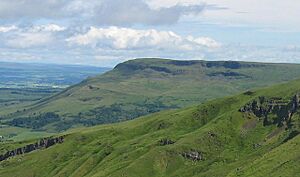Fintry Hills facts for kids
The Fintry Hills are a group of hills in Scotland. They are found west of the city of Stirling. These hills are part of a larger range. The highest point is a peak called Stronend. It stands about 511 meters (1,677 feet) tall. Stronend looks over the area called Strathendrick and the village of Fintry.
The Fintry Hills have steep, rocky sides to the north, west, and south. But the eastern sides slope more gently. They lead down into a valley with the Backside Burn and Endrick Water. A stream called the Boquhan Burn flows northeast. It forms a waterfall on the northern side called the Spout of Ballochleam. A lake named Loch Walton is located at the bottom of the hills' southern slopes.
What are the Fintry Hills Made Of?
The Fintry Hills are made from special rocks. These rocks are volcanic, meaning they came from ancient volcanoes. They are mostly basaltic lavas and tuffs. These rocks formed a very long time ago. This was during a period called the Carboniferous period.
Volcanic Rocks and Layers
The volcanic rocks here are part of something called the Clyde Plateau Volcanic Formation. Think of it like a giant stack of pancakes. Each "pancake" is a different layer of rock. Geologists study these layers to understand the Earth's history.
The main types of rock layers found here include:
- Lava from the Spout of Ballochleam
- Lava from the Fintry Hills
- Lava from the Shelloch Burn
- Another layer of Spout of Ballochleam lava
- A layer of sandstone and other broken rock pieces
- Lava from Skiddaw
The highest point, Stronend, is made from the Shelloch Burn lavas. This is because the whole stack of rock layers is tilted. The tall cliffs on the northern side are made from the Spout of Ballochleam lavas. You can also see lots of rock that has slipped down from these cliffs.
Older Rocks Below
Underneath these volcanic rocks are older layers. These are sedimentary rocks. They formed from sand, silt, and mud over millions of years. These older rocks are found on the lower parts of the hills. They include the Clyde Sandstone Formation and the Ballaggan Formation. These rocks are also from the Carboniferous period.
Sometimes, molten rock pushed its way into the existing layers. These are called dykes. They are like walls of rock that cut through the other layers. You can see these dykes on the southern parts of the Fintry Hills.


